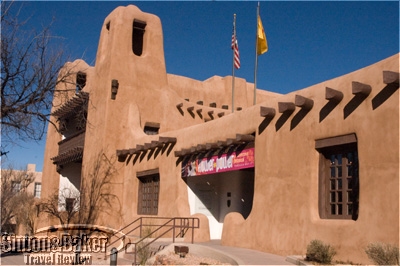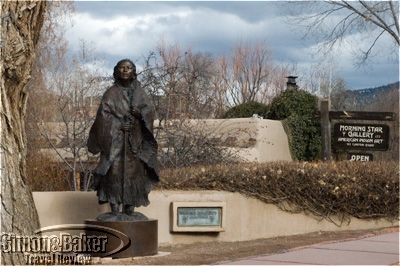

The Georgia O’Keeffe Museum, the largest single repository in the world of the works of this major American artist, is located in the center of town, a few steps away from the Plaza. Just two miles away on Museum Hill, four museums are clustered around a central plaza, including the Museum of Indian Arts and Culture and the Museum of International Folk Art. Additionally, there are 250 art galleries downtown around the Plaza as well as along Canyon Road. This legendary mile-long stretch of galleries features seemingly every type and style of visual art. Santa Fe is said to be one of the largest art centers in the country, after New York and Los Angeles.
For music lovers, Santa Fe is best known for its opera season, a summer tradition that goes back half a century, with daily performances from late June through August. The Santa Fe Opera is a spectacular amphitheatre in the hills just north of the city, with sweeping views of the Sangre de Cristo and Jemez mountains and breathtaking sunsets. But the Santa Fe music scene doesn’t stop at opera. The Chamber Music Festival runs from early July through late August. In addition to traditional chamber pieces, it features modern, jazz and world music. At the other end of the musical spectrum, the Annual Traditional and Blue Grass Music Festival has long been a late August tradition.
The culinary arts also flourish in this unabashedly creative city. On my latest visit, whether I was yearning for multi-star contemporary or classic cuisine or just a quick bite with a southwestern flair, my main challenge was to select from a list of acclaimed eateries too long to work my way through in one single stay.
To renew the body, mind and spirit after so much artistic stimulation, Santa Fe is home to several spas where therapists recreate the ancient remedies and rituals of the Southwest, while others offer treatments grounded in timeless traditions from as far away as Indonesia and Japan.
For all its seemingly inexhaustible wealth of artistic treasures and activities, its memorable restaurants, sensuous spas and breathtaking Rocky Mountains vistas, Santa Fe has maintained the laid-back atmosphere of a high desert small town. I fell in love with the city on my first visit two decades ago, and have returned several times over the years. Whether for a gathering of friends, a romantic get-away or a rejuvenating solo retreat, I always enjoy its warm welcome and unique charm.
Currency U.S. Dollar
Electrical Current 120 Volt
How To Get There The Santa Fe Municipal Airport is nine miles (14 kilometers) southwest of the city. There were several daily flights to and from Denver, Colorado, via regional carrier Great Lakes Airlines. However, most travelers may find it more convenient to fly into Albuquerque International Sunport, located 60 miles (96 kilometers) south of Santa Fe and with daily non-stop flights by major U.S. airlines from their gateway cities. Several reliable shuttle services ran hourly throughout the day between the airport and major Santa Fe hotels. Advanced reservations were recommended. Amtrak’s Southwest Chief train service stopped in Lamy, 18 miles (29 kilometers) south of Santa Fe, with shuttle service available to the city.
Location At an altitude of 7,000 feet (2,133 meters) in the Sangre de Cristo mountain range of the Rocky Mountains, in northern New Mexico, U.S.A.
Technology High speed internet connectivity was widely available. Cell phone reception was excellent wherever I went in the city.
Time GMY/UTC minus seven hours (e.g. U.S. Mountain time)
Transportation In the downtown area, most tourist attractions were located within easy walking distance of the Plaza and each other. To visit further a field, the local transit agency Santa Fe Trail operated eight bus routes that served most areas of the city, including Museum Hill. The routes originated at the Downtown Transit Center, one block west of the Plaza. While it is possible to drive in the center of town, traffic on the narrow one-way streets was a challenge, and parking even more so, especially during the height of the tourist season.
On Museum Hill, the Museum of Indian Arts and Culture featured an outstanding collection of classic and contemporary Southwestern Indian pottery, baskets, weavings, paintings, sculptures and jewelry, and a comprehensive permanent exhibit tracing the life of American Indians from Paleo-Indian times to the present. Next door, the Museum of International Folk Art showcased the largest international folk art collection in the world, with more than 130,000 objects from 100 nations, including a remarkable collection of antique toys.
I especially enjoyed strolling along Canyon Road and weaving in and out of the many art galleries through beautifully landscaped courtyard filled with sculptures ranging in style from the classic to modern and whimsical, and from life size to colossal. With the mountains as a backdrop, the entire area had the feel of a giant casual indoor-outdoor museum.
ReviewersArticle and photographs by Josette King
Would You Visit Again? Yes





